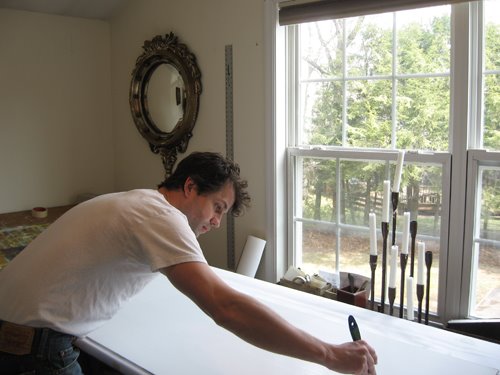Simone Bretz
Reverse painting on glass became popular in Federal America and was practiced mainly by foreign-born artists in Boston, Salem, Philadelphia, and Baltimore. For example, "Walker and Chandless, Painters, in General, from Dublin and London," advertised "Painting on Glass and Transparent Painting" in the Maryland Gazette in 1790. Such paintings, with subjects ranging from flowers and geometric designs to allegory, mythology, and scenic views, were usually incorporated into mirrors, clocks, and other furniture. Ten reverse-painted glass panels, varied in size and shape, can be seen on a neo-classical sideboard in the collection of the Department of American Decorative Arts (Figure 1) that had been commissioned by General David Van Ness (1743–1818) for his Maizefield estate in Dutchess County, New York. Major elements of the designs used on these panels, including urns, cupids, foliage, lyres, and masks, were derived from plates in Thomas Sheraton's The Cabinet-Maker and Upholsterer's Drawing-Book, first published in London in 1791. In an accompanying text Sheraton wrote: "These may be painted, inlaid, or gilt in gold behind glass, and the glass being then beded [sic] in the pilaster, it is secure, and has a good effect."
At the end of the eighteenth century, domestic glass manufactories in several major commercial centers were competing with imported crown and cylinder glass from England, and as such the origin of the panes used on the Van Ness sideboard cannot be assumed. Samples from two panels were analyzed using energy-dispersive X-ray spectrometry (EDS) and both were found to be potash-lime glass with a ratio of potassium to calcium of approximately two to one, containing only relatively small amounts of sodium, magnesium, and aluminum. These results may point to a domestic source, as glass with very similar composition is known to have been made by at least one eighteenth-century American producer, the New Bremen Glassmanufactory in Maryland.
Well-executed reverse-glass paintings do not reveal the complexity of their manufacture. Since the designs are applied to the back of glass panes they must be built up in reverse—starting with the foreground and working "backwards"—which makes corrections virtually impossible. The technique used for the glass panels on the Van Ness sideboard is called metal-foil engraving, although in technical and art historical literature it is often referred to as verre églomisé. Gold leaf was applied to the back of the glass with a size such as clarified egg white, gelatin, or gum, and then engraved with a stylus of metal, wood, or bone. The design was completed by applying a colored background with paint (Figure 2).




No comments:
Post a Comment